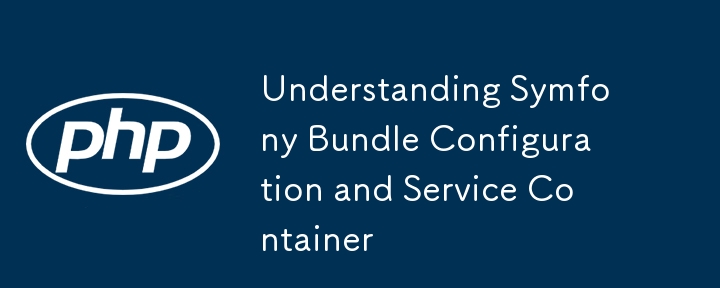Home >Backend Development >PHP Tutorial >Understanding Symfony Bundle Configuration and Service Container
Understanding Symfony Bundle Configuration and Service Container
- William ShakespeareOriginal
- 2025-02-22 09:25:08634browse

This article explores Symfony2 bundle configuration and its interaction with the dependency injection container. These concepts can be challenging for newcomers, particularly those unfamiliar with dependency injection. The examples here use YAML, although Symfony supports XML and PHP arrays. The choice depends on preference; there's no single "best" option.
Key Concepts:
- Symfony Bundles: Similar to plugins, bundles encapsulate features (blogs, forums, etc.). They promote modularity and code reuse. They can be pre-built or custom-created.
- Bundle Configuration: Can be configured directly in the main application configuration file (simpler, but less portable) or in dedicated bundle configuration files (more modular and reusable). Semantic configuration, using an extension class, offers the most flexibility for complex, distributable bundles.
- Dependency Injection Container: Manages service lifecycles and dependencies, resulting in cleaner, more maintainable, and testable code.
-
Debugging: Use console commands like
debug:containeranddebug:configto troubleshoot service registrations and configurations.
Bundle Creation:
A bundle is a directory containing files (PHP, CSS, JavaScript, images) implementing a single feature. In Symfony2, almost everything is a bundle. When creating a bundle (manually or using php app/console generate:bundle), the BundleNameBundle.php file is crucial. Its class extends SymfonyComponentHttpKernelBundleBundle and registers the bundle in AppKernel::registerBundles(). The optional BundleNameExtension.php (in the DependencyInjection folder) loads and manages the bundle's configuration.
Loading Bundle Configuration (Easy Way):
The simplest approach configures parameters and services directly within app/config/config.yml. While functional, this tightly couples the bundle to the application, limiting portability. A better (though still less ideal) alternative is to create a separate configuration file (e.g., Resources/config/services.yml) within the bundle and import it into the main configuration file:
<code class="language-yaml">imports:
- { resource: parameters.yml }
- { resource: security.yml }
- { resource: ../../src/Cvuorinen/ExampleBundle/Resources/config/services.yml }</code>
Loading Bundle Configuration (Semantic Way):
The BundleNameExtension.php class handles configuration loading. It uses a Configuration.php class (also in DependencyInjection) for validation and processing of bundle-related configurations from app/config/. The extension then loads bundle-specific configuration (from Resources/config/) using a loader (e.g., YamlFileLoader). Services defined here can use parameters from the main application configuration. This approach is particularly useful for creating reusable, distributable bundles.
Configuration File Structure:
Configuration files primarily contain parameters and services.
-
Parameters: Static values (credentials, API keys, URLs). Defined under the
parameterskey. Best practice is to define service class names as parameters for better extensibility. -
Services: Classes containing business logic. Defining them in the configuration file leverages dependency injection.
Example services.yml:
<code class="language-yaml">imports:
- { resource: parameters.yml }
- { resource: security.yml }
- { resource: ../../src/Cvuorinen/ExampleBundle/Resources/config/services.yml }</code>
Use app/console container:debug to test and debug the configuration.
Using Services in a Controller:
A simple Greeter service:
<code class="language-yaml">parameters:
cvuorinen_example.greeter.class: Cvuorinen\ExampleBundle\Service\Greeter
cvuorinen_example.greeter.greeting: "Hello"
services:
cvuorinen_example.greeter:
class: %cvuorinen_example.greeter.class%
arguments: [%cvuorinen_example.greeter.greeting%]</code>
A controller using the service:
<code class="language-php">namespace Cvuorinen\ExampleBundle\Service;
class Greeter
{
public function greet($name) { return "Hello $name"; }
}</code>
Dependency Injection:
The example above shows basic constructor injection. Symfony also supports setter and property injection. Services can be declared private to limit their accessibility. Factories can be used to create services (e.g., using the Doctrine entity manager to create repositories).
Conclusion:
This provides a comprehensive overview of Symfony bundle configuration and dependency injection. Further exploration of advanced topics (overriding configurations, parameter sharing, defining controllers as services) is encouraged. Remember to consult the official Symfony documentation for detailed information. Avoid injecting the service container itself into services to maintain loose coupling. The FAQs section is omitted as it is redundant given the detailed explanation above.
The above is the detailed content of Understanding Symfony Bundle Configuration and Service Container. For more information, please follow other related articles on the PHP Chinese website!

